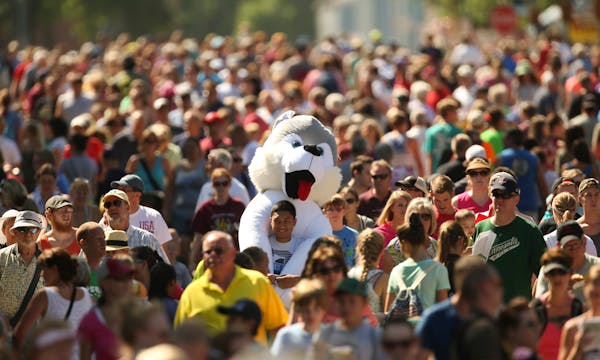Why are Honeycrisp apples still so expensive??
John Welsh of St. Paul was an immediate convert to the explosive, sweet and juicy crunch of Honeycrisp apples when they were first introduced in the late 1990s.
"My generation was raised on Red Delicious and those are less than good apples," he said after originally calling them a word not fit for print. "Honeycrisp reintroduced me to eating good apples."
In Welsh's mind, Honeycrisps possess only one sour note — their high price. He remembers being told that prices would decline as plantings and crop harvests increased. But that hasn't really happened.
So recently, he wondered: "Why are Honeycrisp apples still so expensive? I thought by this time the farmers would be producing enough so the cost differences would not be so profound."
He submitted this question to the Star Tribune's Curious Minnesota project, a community-driven reporting series fueled by inquiring readers. Welsh's question won a vote conducted live at the Minnesota State Fair.
David Bedford, who developed the Honeycrisp at the University of Minnesota and released it to growers in 1991, squashed speculation that royalties paid to the U keep the price high. While it is true that farmers had to pay a royalty of up to $1.25 per tree under patent, it expired in the U.S. in 2008 and last month in Canada. The U still collects royalties from trees sold in Chile, Europe and New Zealand. "We don't set retail prices," he said.
So far the U has collected $16.5 million in royalties from Honeycrisp, making it the university's third most profitable invention after Ziagen and a vaccine to protect against PRRS, a pig disease.
The simple answer to the apple's high price lies in its prickly, finicky nature. "It's one of the most difficult apples to grow," said Mark Seetin, director of Regulatory and Industry Affairs at the U.S. Apple Association in Virginia. "It tends to like to bear fruit every other year and to achieve annual production requires significant additional labor."
Its thin skin creates a delectable crunch that fans love but growers curse. Most apples produce a "pack out" rate of 80 to 90%, indicating that nearly 90% of the harvested crop can be sold as fresh. But Honeycrisp's pack out rate is between 60 and 65%. "That means that 35% of your crop is going as juice," Bedford said. "And juice only captures one-tenth the value of a fresh apple."
Labor costs for Honeycrisp are higher than other apples because it's one of the only apples that has to have its stem clipped so it doesn't puncture the skin of neighboring apples when packed. "Apples pickers are used to picking with two hands, but with Honeycrisp you have to pick with one hand and clip with the other," Bedford said. "With more labor costs and a 60% pack out, you have to charge more."
Many consumers assumed that the price would decline as more farmers planted Honeycrisp trees and expanded the supplies. Supplies have greatly expanded, nearly doubling production in just the last four years. Honeycrisp is now estimated to become the fourth best-selling apple this year and the third best seller in 2020. It will likely overtake Granny Smith this year and Fuji next year, leaving Gala in the No. 1 spot and Red Delicious at No. 2, stubbornly refusing to go down without a fight.
How expensive is Honeycrisp? Recent price checks found it as high as $3.99 per pound in local stores but frequently on sale during peak season. It's not unusual to see it discounted to $2.49 or $1.99 per pound. Aldi recently had a 2-pound bag on sale for $1.89. The sale price, although rare, beats regular prices of Gala, SweeTango, Zestar and Pink Lady. "In general, the everyday price of Honeycrisp has come down about 30% since it was introduced," said Don Roper, vice president of sales and marketing at Honeybear, a Minnesota-based grower, packer and supplier of apples nationwide. "It's about $2.49 on average today compared to $3.99 at its heyday."
Welsh gets his fill of Honeycrisp during the sale season but when prices revert to more than $3 per pound, he switches to second tier choices. Many consumers don't make that switch to lower priced apples, however. When they're still willing to pay a higher price, suppliers don't feel as much pressure to lower it.
Maybe there's some comfort knowing that it could be worse — devotees of the posh First Kiss apple released last year by the U have yet to see a good sale.
---
If you'd like to submit a Curious Minnesota question, fill out the form below:
Read more Curious Minnesota stories:
How did these 11 Minnesota towns get their unusual names?
Has Minnesota every had a major earthquake?
How did the Twin Cities become a hub for Somali immigrants?
Why was Minneapolis' mansion street destroyed, but St. Paul's survived?
Why won't anyone in Minnesota take the last piece of food?
Is Minnesota's tiny Lake Itasca the true source of the Mississippi River?
Why isn't Isle Royale a part of Minnesota?
Why is Uptown south of downtown in Minneapolis?


